
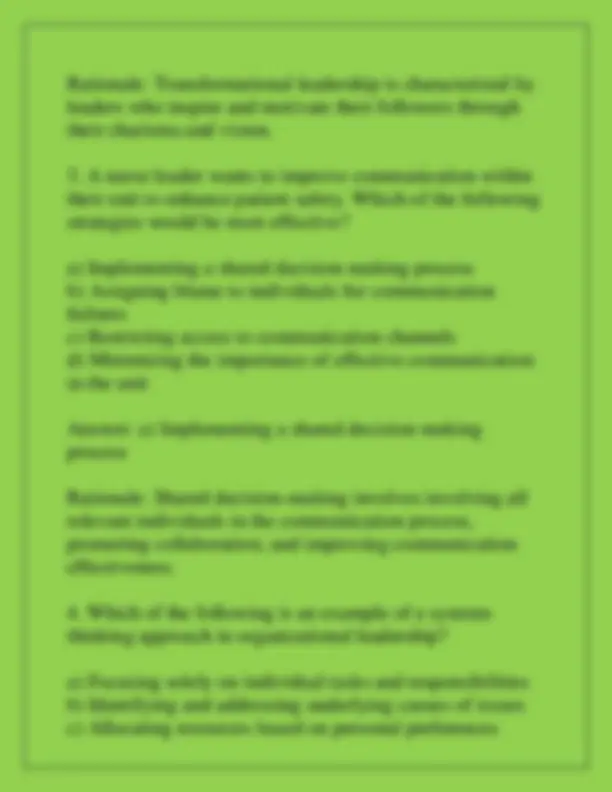
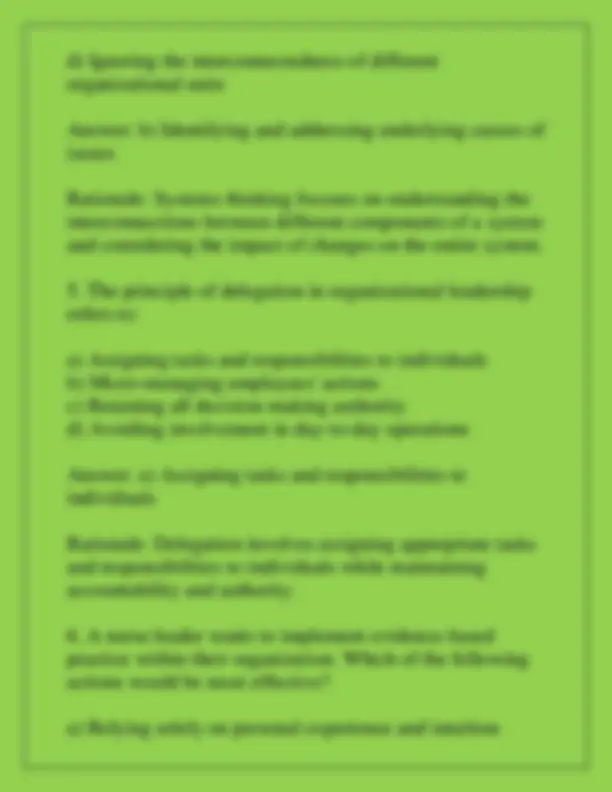

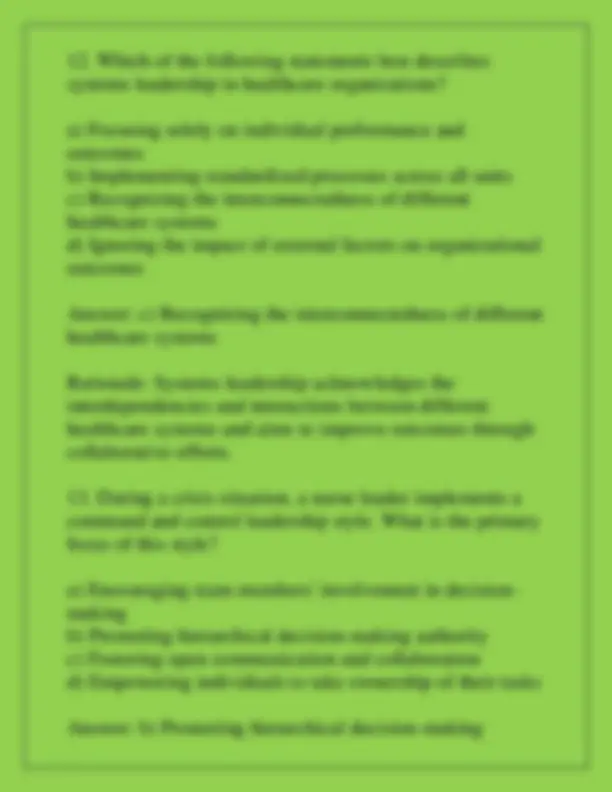
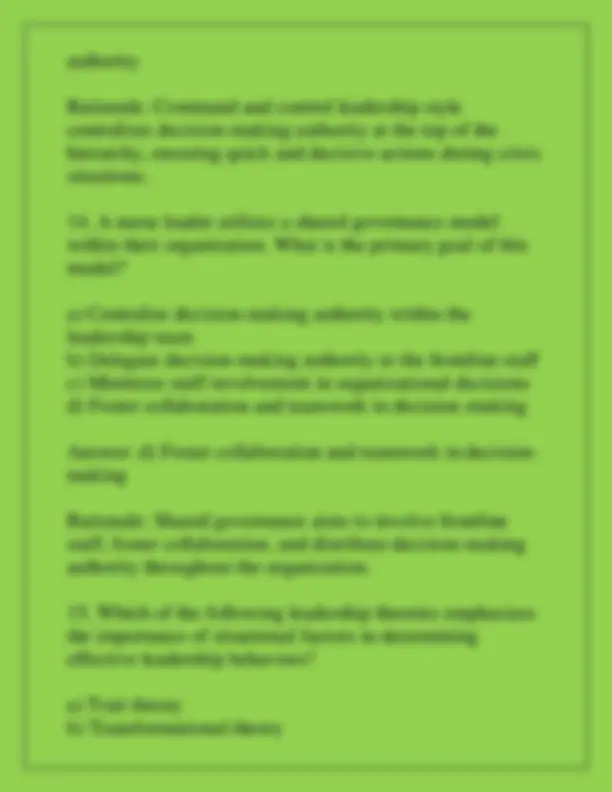
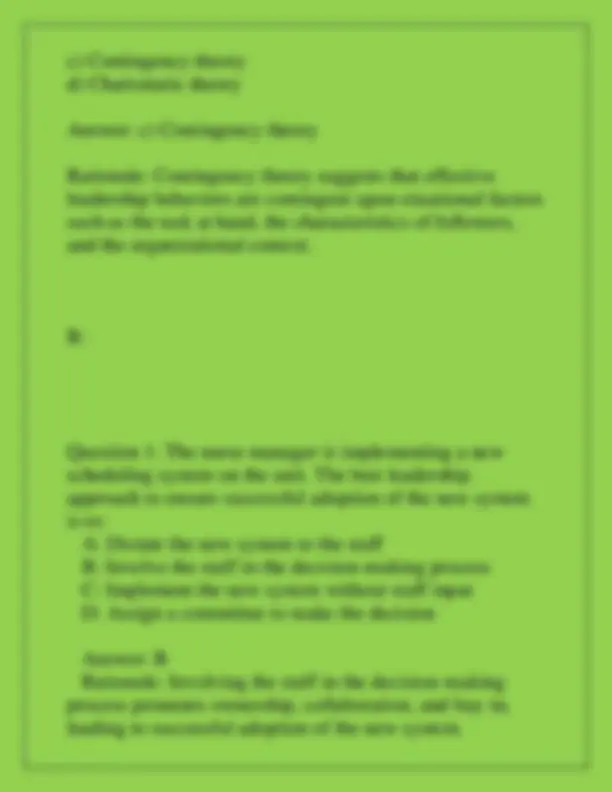
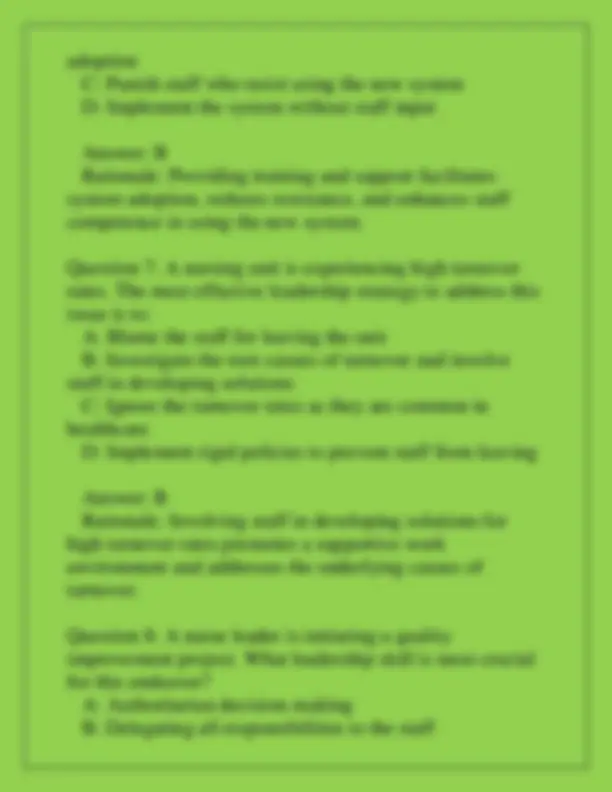
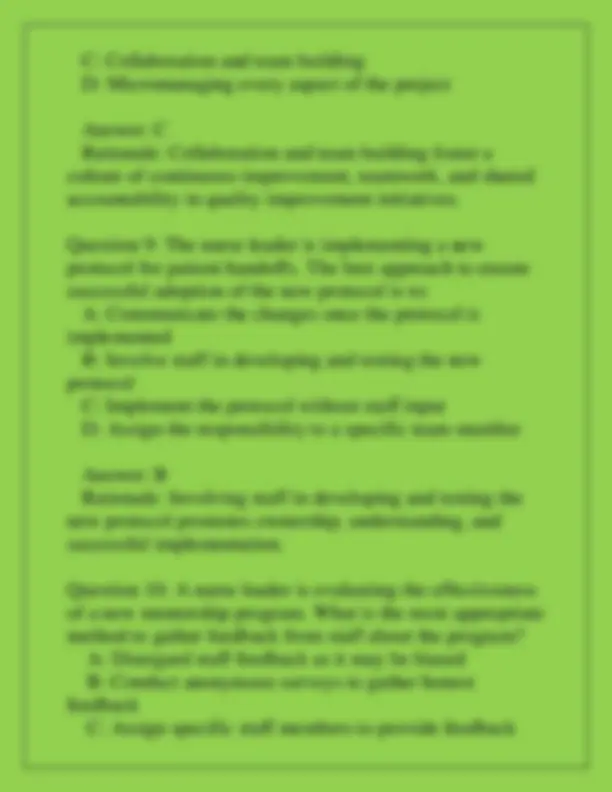
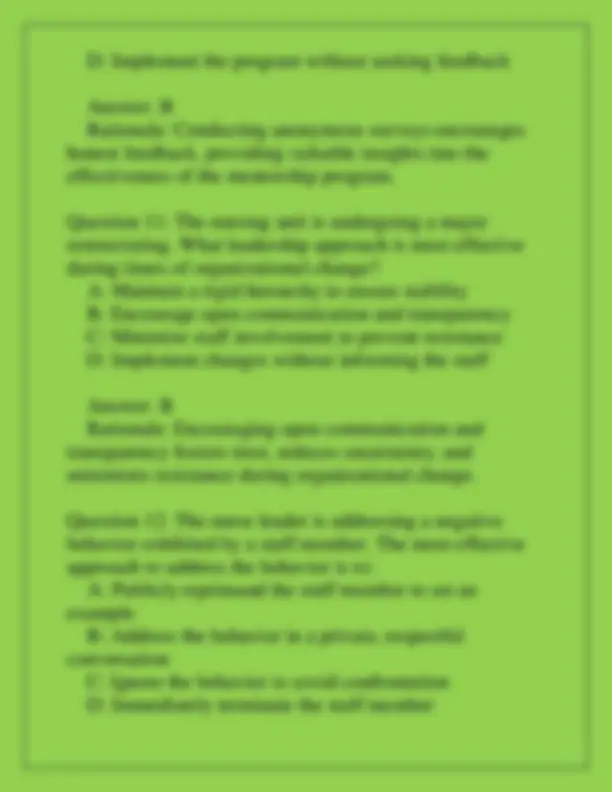
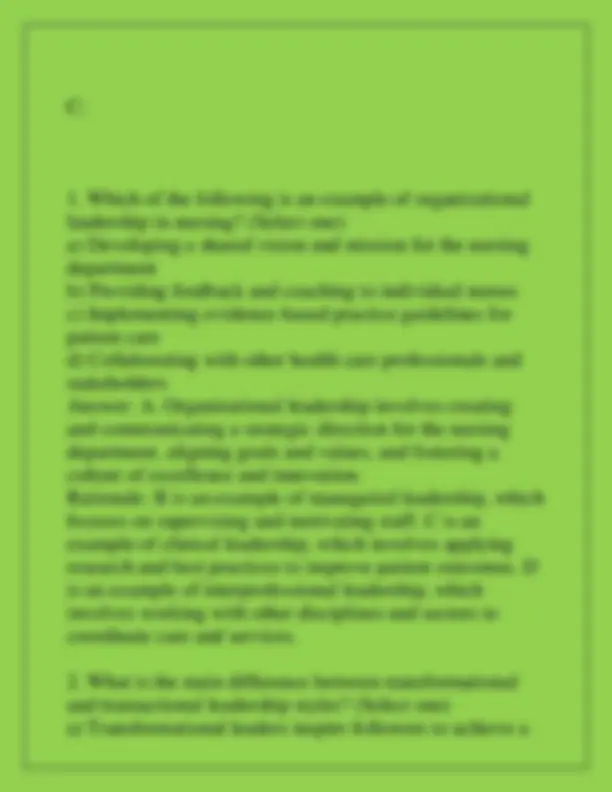
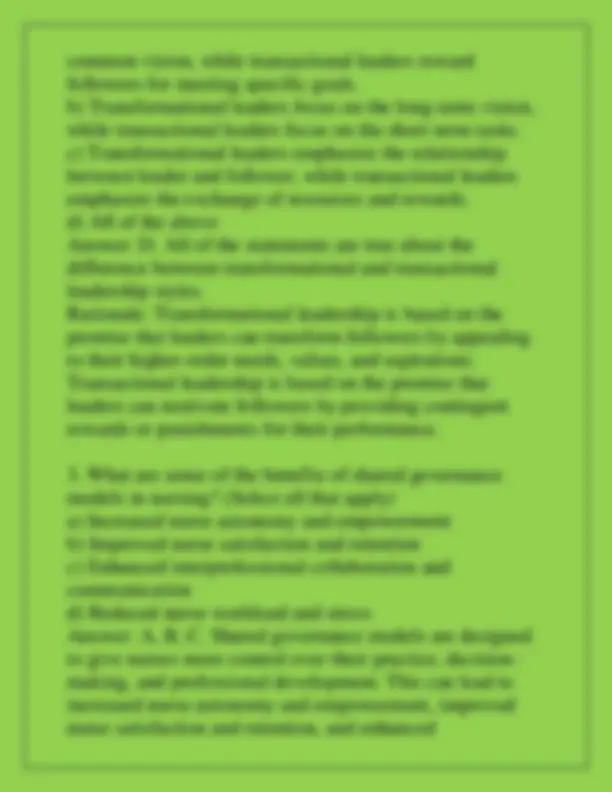
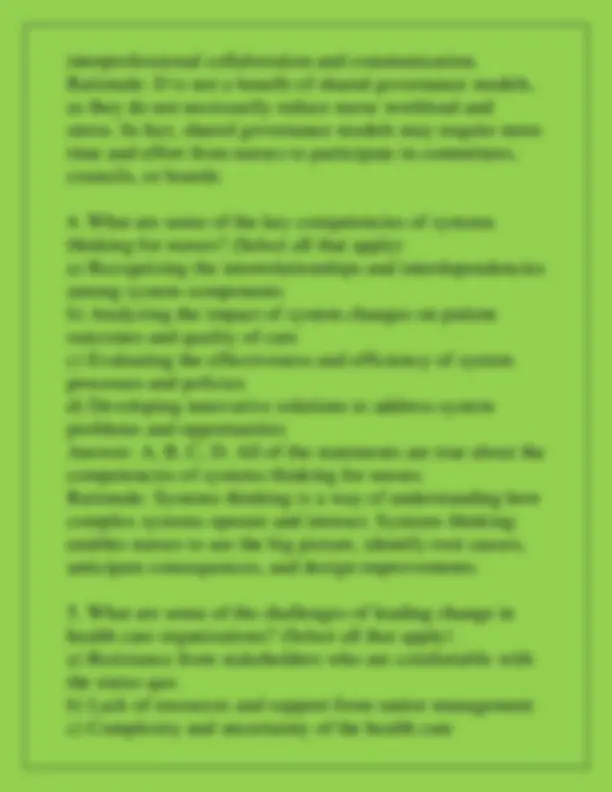


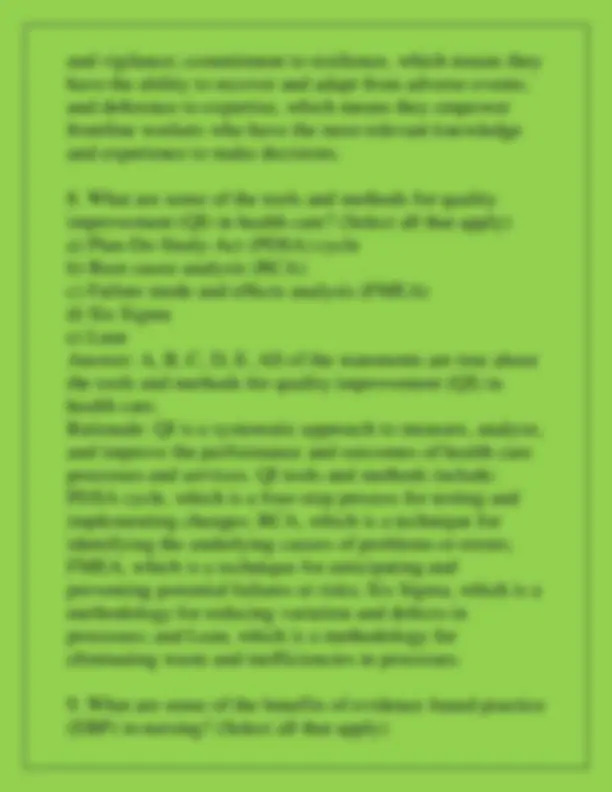
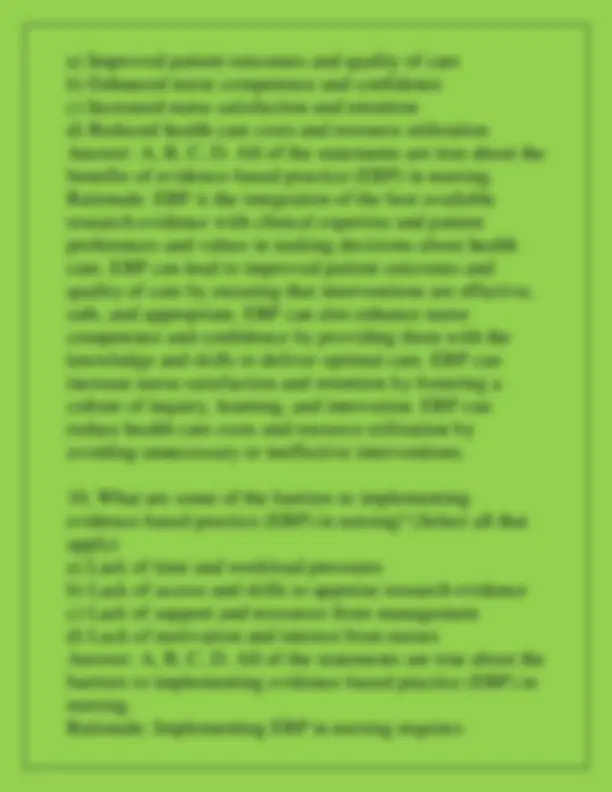
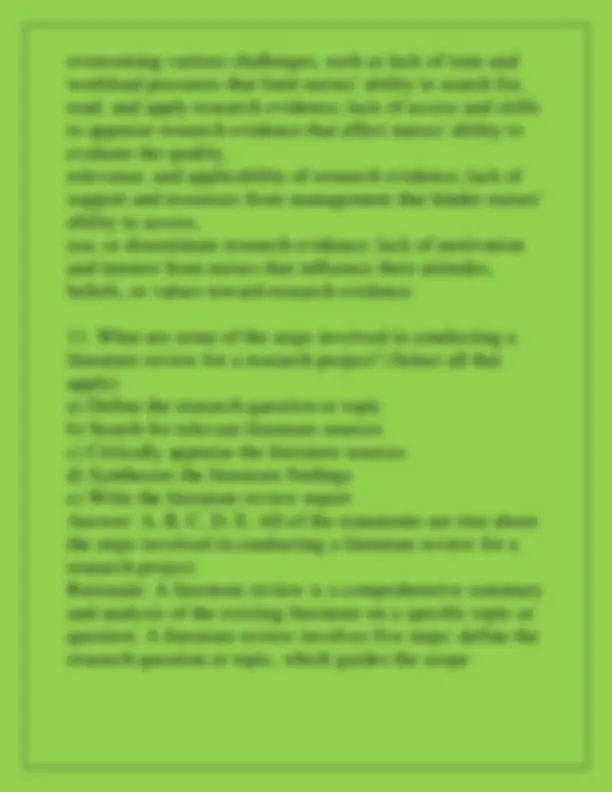



Study with the several resources on Docsity

Earn points by helping other students or get them with a premium plan


Prepare for your exams
Study with the several resources on Docsity

Earn points to download
Earn points by helping other students or get them with a premium plan
Community
Ask the community for help and clear up your study doubts
Discover the best universities in your country according to Docsity users
Free resources
Download our free guides on studying techniques, anxiety management strategies, and thesis advice from Docsity tutors
A set of questions and answers related to organizational leadership, including definitions, leadership styles, teamwork, change management, and conflict resolution. The document also provides rationales for each answer, explaining the reasoning behind the correct choice. The questions are designed to test the reader's knowledge and understanding of key concepts in organizational leadership and their application in healthcare settings.
Typology: Exams
1 / 26

This page cannot be seen from the preview
Don't miss anything!



















d) Ignoring the interconnectedness of different organizational units Answer: b) Identifying and addressing underlying causes of issues Rationale: Systems thinking focuses on understanding the interconnections between different components of a system and considering the impact of changes on the entire system.
b) Encouraging team members to critically evaluate research findings c) Ignoring current research and literature d) Discouraging staff from challenging established practices Answer: b) Encouraging team members to critically evaluate research findings Rationale: Implementing evidence-based practice requires encouraging staff to critically evaluate research findings and apply evidence-based solutions to improve patient outcomes.
c) Contingency theory d) Charismatic theory Answer: c) Contingency theory Rationale: Contingency theory suggests that effective leadership behaviors are contingent upon situational factors such as the task at hand, the characteristics of followers, and the organizational context. B: Question 1: The nurse manager is implementing a new scheduling system on the unit. The best leadership approach to ensure successful adoption of the new system is to: A: Dictate the new system to the staff B: Involve the staff in the decision-making process C: Implement the new system without staff input D: Assign a committee to make the decision Answer: B Rationale: Involving the staff in the decision-making process promotes ownership, collaboration, and buy-in, leading to successful adoption of the new system.
Question 2: A nurse leader is addressing a conflict between two staff members. The most effective conflict resolution strategy is to: A: Ignore the conflict and hope it resolves itself B: Arbitrarily impose a solution C: Facilitate a discussion to find a mutually agreeable solution D: Side with one staff member to end the conflict Answer: C Rationale: Facilitating a discussion to find a mutually agreeable solution promotes open communication and teamwork, leading to a resolution that satisfies both parties. Question 3: When implementing a change in practice, the nurse leader should prioritize: A: Enforcing the change immediately B: Communicating the rationale for the change to the staff C: Minimizing staff involvement to avoid resistance D: Implementing the change without staff awareness Answer: B Rationale: Communicating the rationale for the change to the staff promotes understanding and reduces resistance, leading to smoother implementation. Question 4: In a healthcare setting, transformational leadership is characterized by:
adoption C: Punish staff who resist using the new system D: Implement the system without staff input Answer: B Rationale: Providing training and support facilitates system adoption, reduces resistance, and enhances staff competence in using the new system. Question 7: A nursing unit is experiencing high turnover rates. The most effective leadership strategy to address this issue is to: A: Blame the staff for leaving the unit B: Investigate the root causes of turnover and involve staff in developing solutions C: Ignore the turnover rates as they are common in healthcare D: Implement rigid policies to prevent staff from leaving Answer: B Rationale: Involving staff in developing solutions for high turnover rates promotes a supportive work environment and addresses the underlying causes of turnover. Question 8: A nurse leader is initiating a quality improvement project. What leadership skill is most crucial for this endeavor? A: Authoritarian decision-making B: Delegating all responsibilities to the staff
C: Collaboration and team building D: Micromanaging every aspect of the project Answer: C Rationale: Collaboration and team building foster a culture of continuous improvement, teamwork, and shared accountability in quality improvement initiatives. Question 9: The nurse leader is implementing a new protocol for patient handoffs. The best approach to ensure successful adoption of the new protocol is to: A: Communicate the changes once the protocol is implemented B: Involve staff in developing and testing the new protocol C: Implement the protocol without staff input D: Assign the responsibility to a specific team member Answer: B Rationale: Involving staff in developing and testing the new protocol promotes ownership, understanding, and successful implementation. Question 10: A nurse leader is evaluating the effectiveness of a new mentorship program. What is the most appropriate method to gather feedback from staff about the program? A: Disregard staff feedback as it may be biased B: Conduct anonymous surveys to gather honest feedback C: Assign specific staff members to provide feedback
Answer: B Rationale: Addressing the behavior in a private, respectful conversation promotes accountability, professional development, and a supportive work environment. Question 13: A nurse leader is developing a mentorship program for new graduates. The primary goal of the program is to: A: Isolate new graduates to prevent errors B: Provide support and guidance to facilitate transition into practice C: Assign heavy workloads to accelerate learning D: Exclude new graduates from unit activities Answer: B Rationale: Providing support and guidance through a mentorship program facilitates new graduates' transition into practice, promotes learning, and enhances patient care. Question 14: The nurse leader is initiating a culture change on the unit. The most effective approach to promote a positive culture shift is to: A: Enforce the new culture without staff input B: Engage staff in defining and shaping the desired culture C: Ignore the current culture as it is irrelevant to patient care D: Assign the responsibility to a specific staff member
Answer: B Rationale: Engaging staff in defining and shaping the desired culture fosters ownership, commitment, and a positive shift in the unit's culture. Question 15: A nurse leader is promoting interprofessional collaboration within the healthcare team. The primary benefit of interprofessional collaboration is to: A: Create division and competition among healthcare professionals B: Enhance patient care through teamwork and shared decision-making C: Exclude other healthcare professionals from decision- making processes D: Assign specific roles to each healthcare professional without collaboration Answer: B Rationale: Interprofessional collaboration enhances patient care by fostering teamwork, shared decision- making, and leveraging the expertise of different healthcare professionals.
common vision, while transactional leaders reward followers for meeting specific goals. b) Transformational leaders focus on the long-term vision, while transactional leaders focus on the short-term tasks. c) Transformational leaders emphasize the relationship between leader and follower, while transactional leaders emphasize the exchange of resources and rewards. d) All of the above Answer: D. All of the statements are true about the difference between transformational and transactional leadership styles. Rationale: Transformational leadership is based on the premise that leaders can transform followers by appealing to their higher-order needs, values, and aspirations. Transactional leadership is based on the premise that leaders can motivate followers by providing contingent rewards or punishments for their performance.
interprofessional collaboration and communication. Rationale: D is not a benefit of shared governance models, as they do not necessarily reduce nurse workload and stress. In fact, shared governance models may require more time and effort from nurses to participate in committees, councils, or boards.